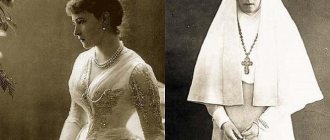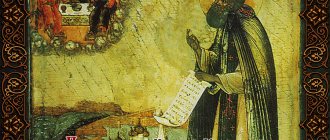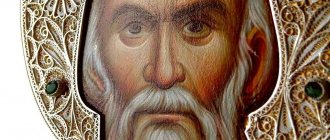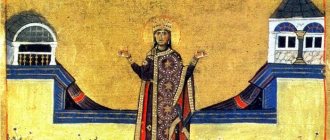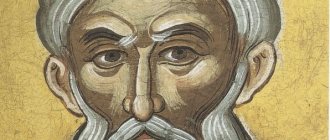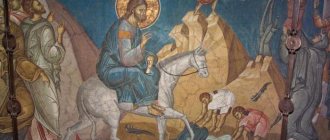| St. Athanasius of Alexandria |
Athanasius the Great
(c. 297 - 373), Archbishop of Alexandria, Father of the Church, Saint Commemorated January 18 (together with St. Cyril of Alexandria) and May 2
Born around 297 in the city of Alexandria into a family of pious Christians. He received a good secular education, but acquired even deeper knowledge through diligent study of the Holy Scriptures. From his adolescence, the future great Saint Athanasius became known to the Patriarch of Alexandria, Saint Alexander, under the following circumstances. One day a group of children, among whom was the youth Afanasy, was playing on the seashore. Christian children decided to baptize their pagan peers. The youth Athanasius, whom the children elected as “bishop,” performed baptism, exactly repeating the words he heard in church during this sacrament. Patriarch Alexander observed all this from the window. Then he ordered the children and their parents to be brought to him, talked with them for a long time and, having made sure that the baptism performed by the children in the game was in every way in accordance with the church charter, he recognized the baptism as valid and supplemented it with confirmation.
From that time on, the patriarch oversaw the spiritual education of young Athanasius and over time added him to the clergy, first as a reader, and then ordained him to the rank of deacon. In this rank, Saint Athanasius accompanied Patriarch Alexander in 325 to the First Ecumenical Council in Nicaea. At the Council, Saint Athanasius spoke against the heresy of Arius. This speech was approved by the Orthodox fathers of the Council, and the Arians - open and hidden - hated Athanasius and persecuted him throughout his life.
On June 9, 328, Athanasius was unanimously elected as the successor of Patriarch Alexander to the See of Alexandria. He refused for a long time, considering himself unworthy, but at the insistence of the entire Orthodox population he had to agree, and at the age of 28 he was ordained a bishop and placed at the head of the Alexandrian Church.
| St. Athanasius of Alexandria. Mosaic |
His uncompromising Orthodox position greatly irritated the Arians, who did not disdain any means to overthrow the saint.
Thus, in 334, by order of the emperor, the Council of Caesarea was convened, which considered the accusation of Saint Athanasius the Great of murdering a certain Meletian bishop Arsenius and using his right hand in magic and witchcraft. A severed hand was even presented at the Council as evidence! Despite the call of the emperor himself to appear before the bishops gathered in Caesarea, Saint Athanasius did not appear at the Council. However, Bishop Arsenius, who was declared killed, but in reality was hiding in Thebaid, was soon found by Saint Athanasius. After providing the necessary evidence to Emperor Constantine, the charge was dropped [1]. According to the unsubstantiated slander of the Arians, Saint Athanasius was deposed in 335 by the Council of Tire.
| St. Athanasius the Great, Archbishop. Alexandrian. Byzantine icon |
In the autumn of 335 St.
Athanasius arrived in Constantinople and asked Emperor Constantine the Great to gather all the bishops of the Council of Tire in the capital, so that in his presence they would absolve themselves of the charges brought against him by this Council. The emperor agreed, but in 336 the main anti-Niceans gathered at the Council in Constantinople, they intimidated the bishops with the unfriendly mood of the emperor, and many bishops dispersed to dioceses. Against St. A new, extremely dangerous accusation was brought against Athanasius: that he threatened to interfere with the supply of grain from Egypt to Constantinople. Emperor Constantine exiled St. Athanasius in Augusta Treverov (now Trier). At the same time, the emperor forbade the election of a new bishop to the See of Alexandria [2]. After the death of Emperor Constantine in 337, Athanasius returned from exile in the fall of 338, but his energetic struggle against the Arians aroused their enmity, and a Council was convened against him in Antioch. In the spring of 340, the imperial governor, with the help of armed force, installed the Arian Gregory as archbishop of Alexandria. Athanasius fled to Rome to Archbishop Julius I, through whose efforts he was recognized as innocent at the Council of Rome in 341 and at the Council of Sardica in 343, and his teaching was declared to be in agreement with the dogmas of the church. The Byzantine Emperor Constantius also favored Athanasius, and obtained permission from his brother Constantius for him to return to Alexandria after the death of Gregory, in October 346. When Constantius, having become the sole monarch, delivered victory to the Arians in 355, Athanasius had to refuse again from spiritual authority. George from Cappadocia was appointed in his place, and when soldiers broke into the church of St. on February 9, 356 at night. Thomas, where Athanasius performed an all-night vigil on the occasion of the holiday, he was forced to flee to the Egyptian desert; but even from here he had a great influence on the flock with his personal authority and writings. Upon the accession of Julian the Apostate to the throne, George was killed during a popular uprising, and Athanasius could return to Alexandria in February 362, but his zealous activities, tending to pacify the church, aroused the displeasure of the emperor, so that on October 25, 362 he had to go into exile for the fourth time, this time to the Thebaid desert. After the fall of Julian, Athanasius returned to Alexandria in February 364, but during the reign of Emperor Valens he was forced to abandon the city once again from October 365 to February 366; from then on he was no longer disturbed until his death.
Died on May 2, 373, at the age of 76.
| Svtt. Athanasius and Cyril of Alexandria. Miniature from the Minology of Basil II, c. 979-989 (Vatican Library) |
Of the 45 years of his bishopric, Athanasius spent about 20 years in exile. His character was judged differently during his lifetime. Hated by his opponents until his death, and revered as a saint by his adherents, Athanasius fearlessly fought under the most varied circumstances of life, in word and deed, for one great idea, on the recognition of which, in his conviction, the existence of the Church depended. For the terrible severity with which his enemies reproached him, they, in turn, cruelly repaid him whenever they had the opportunity. As an archpastor, he corresponded to the strict ideal of his time, he knew how, despite his unimpressive appearance, to dominate minds and left his teaching as the legacy of the entire church. In his numerous works of a dogmatic and polemical nature, together with a fiery zeal for Orthodoxy, an outstanding contemplative mind is expressed, with which he far surpassed his opponents; the fervor of deep personal conviction is combined in them with clarity, prudence and accuracy of presentation.
Life of St. Athanasius the Great
The revered minister of the Orthodox Church was born in Alexandria at the end of the 3rd century, around 297. Afanasy's parents are laymen of the intelligent class, adherents of Christianity. He was a capable boy, mastered the exact sciences and humanities and learned Christian rites from the example of his parents.
Religion was an integral part of people's lives at the dawn of Christianity, which was reflected in children's games. One day, the Bishop of Alexandria saw through the window how Christian children were baptizing pagan children. The boy in the role of the priest read the prayer exactly, as in a temple. It was young Afanasy. The bishop took hidden guardianship over him, appointed him as a reader, and then elevated him to the rank of deacon.
Athanasius attended the First Ecumenical Council. The Bishop of Alexandria took the diligent youth with him to Nicaea and entrusted him with delivering a denunciatory speech against the Aryan heresy at the meeting. The young deacon met with the approval of Orthodox Christians. The Arians present harbored hatred. When Athanasius was elected as the new bishop, the heretics tried to dishonor him by any means.
The Arians called the saint a sorcerer and murderer of Bishop Arsenius of Miletus. Afanasy's opponents provided evidence - a severed hand allegedly belonging to the murdered man. Then the bishop provided Arsenius alive, who was hiding in Thebias. But at the Council of Tire, Athanasius was unable to prevent the total pressure of the anti-Niceans on the Christian bishops. He was deprived of his high rank and sent into exile.
The saint spent two years in the city of Augusta Treverov. Upon returning to Alexandria, he was again accused of embezzling the church treasury. After the illegal appointment of the Arian priest Gregory as bishop, Athanasius turned to the Roman archbishop for help. The saint was acquitted, but he returned to Alexandria only after the death of Gregory.
Over the next 10 years, Athanasius went into exile five times. His zealous pastoral activities aroused the wrath of three emperors - Constantius, Julian the Apostate and Valens. But even from the Egyptian desert the saint exerted a great influence on believers through oral and written sermons. The bishop finally regained the trust of church officials and the government in 366. He left his post only after his death in 373.
Childhood. Youth
Athanasius of Alexandria is revered by the Church as an outstanding church writer, a great saint, and a fighter for the purity of Orthodox doctrine.
We do not know with certainty either about Athanasius’s parents, or about the date of his birth, or about his childhood.
If you follow some data, even in his early childhood he baptized his peers, as if playing. However, the local bishop, having learned about what had happened and judged, considered these Baptisms to be valid. It is difficult to say how true this legend is. In any case, there is no reason to unequivocally accept it as truth.
It is known that the saint’s childhood was affected by the era of bloody persecution of Christians. Maybe he or his parents (if they were Christians) felt the consequences of Diocletian's persecution on themselves.
A wide range of general knowledge and knowledge regarding the subjects of Christian faith and morality give reason to believe that in his youth Athanasius received an excellent secular education and was instructed in the truths of the Holy Scriptures and Tradition.
He joined the clergy of the Alexandrian Church quite early. For six years he served as a reader, and then was elevated to the rank of deacon. This period of his life coincided with the spread of one of the most dangerous and destructive heresies - Arianism.
Athanasius was spiritually close to the Bishop of Alexandria Alexander, and when he went to the First Ecumenical Council, he took Athanasius with him.
Veneration of a saint in Orthodoxy
Saint Athanasius is commemorated on two dates:
- January 18 - together with the memory of St. Cyril of Alexandria;
- May 2 is the day of the Assumption.
The administration of the diocese in Alexandria was passed from uncle to nephew. The founder of the family succession was Saint Athanasius, and Cyril was one of his descendants. He also defended Orthodox dogmas and opposed the Nestorian heresy.
The relics of Saint Athanasius are a revered relic from the times of the prosperity of Constantinople. They were transferred to the capital of the Roman Empire from Alexandria. At the beginning of the 13th century, the crusaders brought part of the relics to the Italian monastery of Monte Cassino. In the middle of the 15th century, the holy remains of Athanasius were transported to Venice. In 1973, the saint's finger was delivered to Cairo as a gift from the Pope.
The Bishop of Alexandria was revered by the Moscow princes. It was first mentioned in the Russian monthly calendar, dated to the mid-11th century. Dmitry Donskoy married the daughter of the Prince of Suzdal Evdokia on the day of memory of Afanasy and Kirill. A particle of the relics of the saint of Alexandria was in the reliquary icon of Prince Constantine, son of Dmitry Donskoy.
In Russian cities, churches and thrones were consecrated in honor of St. Athanasius, but the ancient buildings were lost. The saint was especially revered in the Novgorod principality after the miraculous deliverance from the Mongol army and the end of the pestilence.
Conviction and persecution
Despite the obvious falsity of the accusations, a shadow was cast over the Alexandrian saint. Soon the enemies got the emperor to summon Athanasius to the Council in Tyre, from which, given the mood of the majority of the expected participants, nothing good could be expected. And so it happened. Athanasius of Alexandria was deposed from the pulpit and condemned to exile.
Meanwhile, in November 335, he was solemnly welcomed in Tire. From exile, he wrote to his flock, and the believers, in turn, did not give up trying to achieve the return of their beloved saint.
In 336, Arius died under mysterious circumstances, which was regarded by believers as a judgment of God's Truth, and in 337 the death of Emperor Constantine followed.
Iconography
Iconographic monuments about Saint Athanasius have survived to this day. In the Byzantine and Russian Orthodox schools, church ministers were depicted on waist-length icons according to the following rules:
- White hair;
- high forehead;
- wide beard with curly strands;
- dressed in a white chasuble with black crosses;
- the episcopal attribute on the belt is a diamond-shaped “club” scarf with a cross embroidered in the center;
- holding a scroll or Gospel.
Sometimes there are icons with details of the saint’s vestment, emphasizing the rank of bishop - an omophorion or a miter.
Athanasius was depicted in full growth on joint icons with Saint Cyril. On the Novgorod icon of the 15th century, Bishop Leonty of Rostov joined the saints. The figure of the Bishop of Alexandria is inscribed in the image of St. Nicholas with the Deesis among the selected saints. The icon dates back to the 4th century and was also painted by Novgorod masters.
The image of Saint Athanasius was placed on frescoes in ancient churches in Rome, Cappadocia (central region of Turkey), Macedonia, Sicily and Greece. The image of a bishop appears in illustrations of manuscript pages. In one of the ancient drawings, the bishop is immortalized sitting at work on an essay. Nearby there is a table with an open book.
In the Cathedral of St. Mark in Cairo, above the shrine with relics in a niche, an image of St. Athanasius in a red vestment is painted. The niche is decorated with flowers and a gilded frame.
Bibliography[ | ]
Translations[ | ]
Russian translations:
- A brief overview of the Holy Scriptures of the Old and New Testaments. - St. Petersburg, 1841. - T. 1. - 109 p.; T. 2. - 83 p.
- Athanasius of Alexandria
. Creations. / Per. Moscow spirit. academician with entry. Art. A. V. Gorsky. - M., 1851 - 1854. (Series “Creations of the Holy Fathers...”) Part 1. (Vol. 17.) 1851. - 436 p. - Part 2. (Vol. 19.) 1852. - 523 p.
- Part 3. (Vol. 21.) 1853. - 427 p.
- Part 4. (T. 23.) 1854. - 532 p.
- Part 1. 1902. - 471 p.
New translations:
- Excerpts from the Life of Anthony. / Per. T.V. Popova. // Monuments of Byzantine literature of the 4th - 9th centuries / Rep. ed. L. A. Freyberg. - M.: Nauka, 1968. - P. 38-44.
What do they pray to Saint Athanasius for?
Modern Orthodoxy has preserved the tradition of turning to the saint with a prayer for health. As the history of Novgorod shows, Athanasius of Alexandria helps in the fight against epidemics. You can pray to the saint for the well-being of your family and friends, and ask him to protect them from the plague. In church practice, the custom of holding religious processions has been preserved. The procession and prayer service in honor of Saint Athanasius inspired the Russian ancestors.
The Bishop of Alexandria fought against slanderers all his life. He is called upon to help with unfair accusations. They also pray to the saint to resolve any issues related to faith:
- when there is a threat of church schism;
- about admonishing unbelievers and blasphemous relatives;
- about saving people who fell under the influence of sectarians.
The Bishop of Alexandria patronizes men named Athanasius.
Episcopal activities
After the death of Bishop Alexander, which, according to various estimates, occurred in 326 or 328, Athanasius took over the orphaned See of Alexandria. By then he was known as a man of strong faith.
His ideological opponents, the Arians, subsequently claimed that he was elected in violation of canonical rules, by a minority of votes, but this was not so. Lies and slander against Athanasius were among the most common methods used against him by heretics. Subsequently, they made accusations, one more ridiculous than the other.
In addition to the difficulties associated with the fight against Arianism, the saint also had to deal with the consequences of the Melitian schism.
Some time after the First Ecumenical Council, the Arian hierarchs, resorting to hypocritical humility and formally expressed agreement with the teachings of the Ecumenical Church, found an approach to Emperor Constantine and obtained permission from him to return from exile.
Eusebius of Nicomedia, taking advantage of the situation, called on Athanasius of Alexandria to accept into communion the founder of the heresy - the wicked blasphemer and heretic, Arius. The saint, as one would expect, refused, well understanding that the words of the Arians about agreement with the Church were just words.
Then the Eusebians entered into open struggle against him. For this struggle they united with the Melitians. Realizing that it was pointless to fight the orthodox saint on theological grounds, since this would reveal the true attitude of the Arians to the Nicene Creed, they concentrated their efforts on discrediting his personality.
To do this, they resorted to far-fetched and very exotic accusations: that Athanasius illegally burdened the Egyptians with a flax tax; supplies of gold to the conspirator and rebel Phelomen; immoral, immoral behavior; outrage (as if, on the orders of Athanasius, the presbyter of Ischira was beaten, the throne in the temple was overturned, the Chalice was broken, books were burned).
As a result of the attacks, Athanasius was forced to personally meet with the emperor, which he did. Contrary to the wishes of the heretics, he managed to justify himself and reveal the absurdity of these sweeping accusations.
However, Athanasius' enemies were in no hurry to give up hatred and struggle. This time they resorted to a more sophisticated accusation: they spread a rather strange rumor that Athanasius had villainously killed Bishop Arseny. As proof, they showed the hand of the “murdered” bishop. And this despite the fact that in reality Bishop Arseny was alive and hiding in a remote monastery.
Orthodox texts
On the days of remembrance, Saint Athanasius is glorified with traditional hymns.
Troparion
- Thou art a pillar of Orthodoxy, confirming the Divine dogmas of the Church, Hierarch Athanasius: For having preached the Son of One Essence to the Father, thou hast put Arius to shame. Reverend Father, pray to Christ God to grant us great mercy.
Kontakion
- Having planted the teachings of Orthodoxy, you have plucked out the slander of thorns, multiplying the seed of faith by the inspiration of the Spirit, reverend, we sing the same to you, Athanasius.
Literature[ | ]
- Gorsky A.V.
The life of St. Athanasius the Great, Archbishop of Alexandria. - M.; Sergiev Posad, 1851; 1902. - Nikanor (Kamensky N. T.).
St. Athanasius the Great Archbishop. Alexandrian and his selected works. - St. Petersburg, 1893. - Vladimir (Gorkovsky).
Saint Athanasius the Great, Archbishop of Alexandria // Orthodox Theological Encyclopedia. - Petrograd Publishing House. Supplement to the spiritual magazine “Wanderer”, 1901. - T. 2. - Stb. 163 - Asmus V.V., Chichurov I.S., Nikiforov M.V., Fokin A.R., E.P.S., Loseva O.V., Venzel O.V., Gerasimenko N.V.
Afanasy the Great // Orthodox encyclopedia. - M., 2002. - T. IV: “Athanasius - Immortality.” - P. 22-49. — 752 p. — 39,000 copies. — ISBN 5-89572-009-9. - Life of our holy father Athanasius, Archbishop of Alexandria // Lives of the saints in Russian, set out according to the guidance of the Chetyih-Menya of St. Demetrius of Rostov: 12 books, 2 books. add. - M.: Moscow. Synod. typ., 1903-1916. — T. V: January, Day 18.
- Ponomarev A. I.
Athanasius the Great, Archbishop of Alexandria in Monthly // Orthodox Theological Encyclopedia. - Petrograd Publishing House. Supplement to the spiritual magazine “Wanderer”, 1901. - T. 2. - Stb. 163 - Popov I.V.
The religious ideal of St. Athanasius of Alexandria. - Sergiev Posad, 1904. - Socrates Scholastic.
Ch. 15. About the fact that after the Council, when Alexander died, Athanasius was installed as bishop // Church History. - M.: Russian Political Encyclopedia (ROSSPEN), 1996. - 368 p. - Florovsky G.V.
II. Athanasius of Alexandria // Eastern Fathers of the 4th century. From readings at the Orthodox Theological Institute in Paris. - Paris: YMCA-Press, 1931. - pp. 26-38. — (Theology of the Church Fathers). - Shindzhiashvili M.I.
Georgian translations and editions of “The Life of Anthony” by Athanasius of Alexandria. Author's abstract. diss. ... K. philol. n. - Tbilisi, 1979. - Hanson RPC
The Search for the Christian Doctrine of God: The Arian Controversy, 318-381 AD. - New York: Continuum International Publishing Group, 2005. - 960 p. — ISBN 0-5670-3092-X.
Creative heritage
The most significant works of the saint:
- four preaching speeches - refutations of the Arian heresy;
- letter to Bishop Epictetus of Corinth - about the union of the Divine nature and human origin of Jesus Christ;
- “History of the Arians for Monks” is a didactic work demonstrating the struggle of religious movements in the 4th century;
- “Descriptions of Holidays” is a Christian calendar cycle showing the method of calculating chronology in the old days;
- The detailed life of Anthony the Great is a moralizing book recommended for reading by John Chrysostom.
Saint Athanasius left many apologetic works, epistles exposing the Arian heresy, interpretations of Holy Scripture and discussions on morality. The Bishop of Alexandria defended the consubstantiality of the Holy Trinity and argued that relying only on knowledge is detrimental to faith.
Notes[ | ]
- History of the Patriarchs of the Coptic Church of Alexandria. — Part VIII (English)
- ↑ 1 2
Alexandrian Orthodox Church (Alexandrian Patriarchate). Orthodox encyclopedia. - Edward Siecienski
The Filioque: History of a Doctrinal Controversy. - P. 37. - Milkov V.V.
Understanding history in Ancient Russia. - St. Petersburg: Aletheia, 2000. - 385 p. — ISBN 5-89329-227-8. - ↑ 123
Orthodox Encyclopedia, 2002. - PSRL. - T. 15. - Stb. 83.
- PSRL. - T. 18. - P. 154-155.
- Filters - Throne of Athanasius of Alexandria (undefined)
.
Sobory.Ru
. People's catalog of Orthodox architecture. Access date: March 31, 2022.
